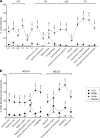Distinct acute effects of LSD, MDMA, and D-amphetamine in healthy subjects
- PMID: 31733631
- PMCID: PMC6969135
- DOI: 10.1038/s41386-019-0569-3
Distinct acute effects of LSD, MDMA, and D-amphetamine in healthy subjects
Abstract
Lysergic acid diethylamide (LSD) is a classic psychedelic, 3,4-methylenedioxymethamphetamine (MDMA) is an empathogen, and D-amphetamine is a classic stimulant. All three substances are used recreationally. LSD and MDMA are being investigated as medications to assist psychotherapy, and D-amphetamine is used for the treatment of attention-deficit/hyperactivity disorder. All three substances induce distinct acute subjective effects. However, differences in acute responses to these prototypical psychoactive substances have not been characterized in a controlled study. We investigated the acute autonomic, subjective, and endocrine effects of single doses of LSD (0.1 mg), MDMA (125 mg), D-amphetamine (40 mg), and placebo in a randomized, double-blind, cross-over study in 28 healthy subjects. All of the substances produced comparable increases in hemodynamic effects, body temperature, and pupil size, indicating equivalent autonomic responses at the doses used. LSD and MDMA increased heart rate more than D-amphetamine, and D-amphetamine increased blood pressure more than LSD and MDMA. LSD induced significantly higher ratings on the 5 Dimensions of Altered States of Consciousness scale and Mystical Experience Questionnaire than MDMA and D-amphetamine. LSD also produced greater subjective drug effects, ego dissolution, introversion, emotional excitation, anxiety, and inactivity than MDMA and D-amphetamine. LSD also induced greater impairments in subjective ratings of concentration, sense of time, and speed of thinking compared with MDMA and D-amphetamine. MDMA produced greater ratings of good drug effects, liking, high, and ego dissolution compared with D-amphetamine. D-Amphetamine increased ratings of activity and concentration compared with LSD. MDMA but not LSD or D-amphetamine increased plasma concentrations of oxytocin. None of the substances altered plasma concentrations of brain-derived neurotrophic factor. These results indicate clearly distinct acute effects of LSD, MDMA, and D-amphetamine and may assist the dose-finding in substance-assisted psychotherapy research.
Figures




References
-
- Schmid Y, Enzler F, Gasser P, Grouzmann E, Preller KH, Vollenweider FX, et al. Acute effects of lysergic acid diethylamide in healthy subjects. Biol Psychiatry. 2015;78:544–53. - PubMed
-
- Preller KH, Herdener M, Pokorny T, Planzer A, Kraehenmann R, Stämpfli P, et al. The fabric of meaning and subjective effects in LSD-induced states depend on serotonin 2A receptor activation. Curr Biol. 2017;27:451–57. - PubMed
-
- Rickli A, Moning OD, Hoener MC, Liechti ME. Receptor interaction profiles of novel psychoactive tryptamines compared with classic hallucinogens. Eur Neuropsychopharmacol. 2016;26:1327–37. - PubMed
Publication types
MeSH terms
Substances
LinkOut - more resources
Full Text Sources
Other Literature Sources
Medical

